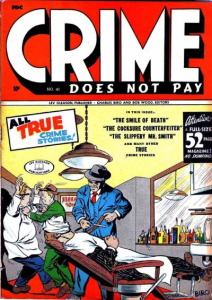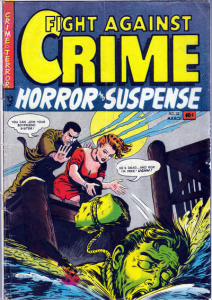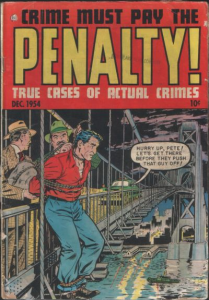Given the ongoing heated discussion over police reform and how to rethink public safety, I guess this is an appropriate occasion to highlight one of my favorite genres: crime fiction. As far as comic books go, although there were precedents, this genre truly boomed in the late 1940s/early 1950s, coinciding with the first waves of film noir and probably appealing to much of the same audiences: men who had come back from WWII and were more interested in violent tales about fucked up lives than in the superhero fantasy that had dominated comics’ war years.
One of the alluring things about noir is the way it delves into shades of grey. Even when featuring vicious, irredeemable characters, its stories tend to humanize at least some of those who find themselves tempted or cornered into acting outside the law. That said, like the movies, comics sought to skew the conservative charge that they were making criminal behavior appealing – and they did so by tacking on ironic and/or downbeat endings where morality often took the form of ‘poetic justice.’ In fact, many of them went one step further by displaying titles that explicitly promised an anti-crime stand, despite the seductively lurid images inside…
The connection to film noir runs deeper than that, though. There is little doubt that comic book creators were avid consumers of crime flicks, which clearly inspired many of their aesthetic choices, from sweaty close-ups to shadowy silhouettes, not to mention the specific look and postures of the various femmes fatales.
The influence was also in terms of the cynical, angst-filled view of postwar society, often blending leftist and reactionary sensibilities. Disturbed veterans, backlash against women’s work-related ascension during the war, and the little guy’s helplessness against corporate capitalism’s moral corruption were recurring themes in film noir. For example, the darkness-drenched psychological thriller High Wall finds a peculiar approach to each of these topics by merging them with the (also very noirish) trope of the amnesiac murderer. That movie also benefits from some great supporting characters, although without reaching the hights of the cast of Pickup on South Street, the phenomenal cult classic about a pickpocket artist who gets more than he bargained for when he accidentally steals a secret microfilm. This latter one is sometimes discarded as tainted by Cold War propaganda because of its communist villains, but the picture is playing on a whole other field, focusing on a trio of lowlifes who are desperately trying to get by while the higher-ups play their geopolitical games (all told through Sam Fuller’s sensationalistic style). Similarly, although the Red Scare context is also pretty inescapable when considering Elia Kazan’s Panic in the Streets (where, living up to the title, everyone is on edge as the authorities’ race to stop a (blatantly allegorical) plague coming from abroad and spreading through the working class and criminal underworld), the main allure is the realistic tour through New Orleans’ lowest milieus, stunningly photographed and culminating in one of noir’s most memorable chases, at a coffee warehouse…
It wasn’t just in American cinema, either. The Italian Bitter Rice, the Japanese Stray Dog, and the French Elevator to the Gallows did similar gestures, tapping into their own society’s tensions and traumas at the time. In the United Kingdom, there was a string of taut, gritty noirs in the turn towards the 1960s, including titles such as Pickup Alley, Hell is a City, and Never Let Go. The latter one, in particular, presents a bleak depiction of a middle class obsessed with consumer goods while getting a lot of mileage out of bourgeois fears, from youth delinquency to the loss of property and even the merciless march of work-related technological dependency.
At their best, comics didn’t merely copy the movies’ narratives and visuals. In anthologies like EC’s Crime SuspenStories and Shock SuspenStories, you could see writers and artists ingeniously translating and reinventing the language of film noir into a new medium. Here are ten short stories that did this wonderfully:
‘Ten Minutes’ (originally published in The Spirit newspaper strip, September 1949), by Jules Feiffer (script), Will Eisner (script and art), Jamison (colors), and Abe Kanegson (letters)
Will Eisner’s strip about the street-level adventures of a domino mask-wearing vigilante is one of the most influential crime comics in the history of the medium, inspiring countless other works throughout the decades, from further takes on The Spirit to Alex Segura’s, Monica Gallagher’s, and George Kambadai’s quirky new spin on the subgenre, The Black Ghost. The noir influence was obvious, but perhaps never more so than in ‘Ten Minutes,’ where we witness the final moments in the life of Freddy, a frustrated young man from a downtrodden neighborhood who makes a decision that changes the course of his life. It’s one of those stories where the Spirit remains in the periphery of the action, with the comic preferring to delve into Freddy’s perspective and doomed fate. I also love the way Eisner plays with pacing, filling the pages with parallel interactions that serve both to lengthen the reading time (thus ramping up the tension) and to convey Freddy’s sense of alienation.
‘The Sewer’ (originally published in Crime SuspenStories #5, cover-dated June-July 1951), by Johnny Craig (script and art), Marie Severin (colors), and Jim Wroten (letters)
Flashback structure? Check. Murder driven by lust? Check. Overwhelming rain? Check. Macabre irony? Check. Desperate guy caught in a nightmarish spiral? Hell yeah. The only noir ingredient missing from ‘The Sewer’ is the black & white chiaroscuro (unless you read the uncolored version in Fantagraphics’ Voodoo Vengeance and Other Stories collection), but that’s ok, because Marie Severin’s color choices contribute to the chilling atmosphere, especially her poetic, green-heavy panels at the end of each death sequence…
‘Piecemeal’ (originally published in Shock SuspenStories #8, cover-dated April-May 1953), by Bill Gaines (script), Al Feldstein (script), Jack Kamen (art), Marie Severin (colors), and Jim Wroten (letters)
Deadly love triangles are a staple of film noir, from The Postman Always Rings Twice to Sudden Fear, and while the mechanics of ‘Piecemeal’ are pretty straightforward, two elements raise it above the crowd. One of them is Sally’s voluptuous femme fatale, who is a cross between Lana Turner and Gloria Grahame in the aforementioned pictures – her interactions with our protagonist are rendered by Jack Kamen in such a way that you can really feel the tingling sexual tension in the air. The other one is the shocking clincher – even those who see it coming are bound to be struck by how horrific things get!
‘From Here to Insanity’ (originally published in Crime SuspenStories #18, cover-dated August-September 1953), by Bill Gaines (plot), Al Feldstein (plot, script), Reed Crandall (art), Marie Severin (colors), and Jim Wroten (letters)
Masterfully plotted, with Al Feldstein’s wordy narration stretching out the suspense, ‘From Here to Insanity’ offers readers a spirited clash between the unstoppable force of an edgy fugitive (drawn by Reed Crandall like a bug-eyed psychopath) and the immovable object that can be a gentle old lady. You cannot look away, as the tense clash is unsettlingly captured by both story and artwork. There is also something to be said about the tale’s gender politics, given the peculiar way in which it delivers a punishment for misogyny (as underlined by the final punchline).
‘Big Racket’ (originally published in Dynamite #4, cover-dated November 1953), by Pete Morisi (art)
I had to include at least one private eye!
My favorite summer read this year was Ernest Mandel’s Delightful Murder: A Social History of the Crime Story, a fascinating analysis of the evolution of literary crime fiction and how it parallels the evolution of crime itself (as well as of organized capitalism). The only time the book – which first came out in 1984 – mentions comics, though, is when denouncing the genre’s post-Mickey Spillane degradation into simplistic, sadistic thrillers which found a semi-fascist low in comic books (in a rare hysterical passage, Mandel blames the medium itself, because of its reliance on visuals over words, concluding apocalyptically that ‘increasing illiteracy undoubtedly constitutes a formal expression of cultural decline, corresponding in its own way to the decline of bourgeois society and the threat of a decline of civilization itself.’)
Prejudices aside, I swear he could be writing about Johnny Dynamite, a nasty detective comic that pushed the boundaries of what this medium could get away with before the institutionalized censorship of the Comics Code Authority. ‘Big Racket’ is a perfect example: it opens with a deadly shoot-out in the dark, followed by a flashback in which Dynamite recalls facing a gangster who used to run a prostitution ring, having sex with a bombshell (who is later tortured), and going on a killing spree. I don’t know who wrote it (perhaps artist Pete Morisi himself), but whoever it was sure captured the tough-guy voice of the era’s pulp prose and movie voice-overs. The closing line, in particular, is as noir as it gets!
‘Well Trained’ (originally published in Shock SuspenStories #15, cover-dated June-July 1954), by Carl Wessler (script), George Evans (art), Marie Severin (colors), and Jim Wroten (letters)
Carl Wessler and George Evans formed one of the greatest partnerships in the history of noir comics, with a solid string of hard-hitting collaborations in the mid-1950s. ‘Well Trained’ is arguably their most visceral: in this hardboiled revenge tale, a cop becomes obsessed with punishing his wife’s killer through the death penalty, effectively using the state as a weapon (thus implicitly recognizing the profoundly tormenting dimension of the countdown towards capital punishment). Readers may find their sympathies shifting as the protagonist’s legalist attitude soon rises up to a sadistic fever pitch.
‘The Squealer’ (originally published in Crime SuspenStories #25, cover-dated October-November 1954), by Jack Oleck (script), George Evans (art), Marie Severin (colors), and Jim Wroten (letters)
Another sordid comic about violent cops, ‘The Squealer’ is more of a character study, delving into the life and mindset of Lieutenant Ed Zimmer. Dirty and brutal, yet also committed to his son and with a trace of self-pity (‘You’re not gonna end up like me, Jerry! You’re gonna be somebody.’), Zimmer is not only the kind of well-rounded, conflicted figure noir is made of, but also the embodiment of the grim postwar era of corrupt institutions and frustrated American dreams which spawned the genre in the first place.
‘In the Bag’ (originally published in Shock SuspenStories #18, cover-dated December 1954 – January 1955), by Carl Wessler (script), Bernie Krigstein (art), Marie Severin (colors), and Jim Wroten (letters)
Wessler also scripted this gripping tale from the point of view of an officer chasing a potential murderer with a suspicious bag. Like ‘Well Trained,’ ‘In the Bag’ is a story of obsession, once again exploring the line between cops’ sense of righteousness and the scarier side of an emboldened police. The great Bernie Krigstein then furthered the psychological intensity through murky, saturated tones and his typical technique of breaking down the action into rows of small moments (one page has 17 panels!), individualizing each step leading up towards the soul-crushing finale.
‘The Customer Is Always Right’ (originally published in San Diego Comic Con Comics #2, cover-dated August 1993), by Frank Miller (script, art)
Jumping forward decades in time, we get this amazing slice of retro-fetishistic neo-noir. Frank Miller’s work is so damn evocative that, even though ‘The Customer Is Always Right’ is just three-pages long, its conversation between two apparent strangers on a rainy balcony manages to pull off a memorably spellbinding mood, not to mention an elegant twist ending that still packs a punch. And yes, reduced to a stark black & white silhouette, the woman above looks practically naked… Sin City plays according to its own rules: everything about it is deliberately exaggerated, from the characters to the contrived, derivative plots and hyper-stylized visuals. (That said, if you look at the original noir period, you’ll find plenty of films where these elements were just as mesmerizingly overblown, both in famous productions like Gilda and, particularly, in second-tier works like The Unsuspected.) This story, in particular, deserves to be considered a modern classic, especially as it is fairly easy to track down, having been republished in multiple Sin City collections, such as the one-shot The Babe Wore Red and other stories and the trade paperback Booze, Broads & Bullets.
‘How Things Work Out’ (originally published in Tomorrow Stories #2, cover-dated November 1999), by Alan Moore (script), Rick Veitch (art), David Baron (colors), and Todd Klein (letters)
As you can tell from the title page above, the densely packed ‘How Things Work Out’ follows the abusive relationship between a gangster and his live-in caretaker’s son, with each panel row focusing on a different decade and a different floor of the same building (with a rotating perspective from page to page). The high concept may sound too gimmicky (in addition to the pastiche elements of Rick Veitch’s artwork and Todd Klein’s lettering), but leave it to Alan Moore to actually imbue the tale with quasi-poetic emotional beats. Indeed, the second published story of the Spirit-inspired Greyshirt comic lives up to its roots. It’s nothing short of brilliant.













